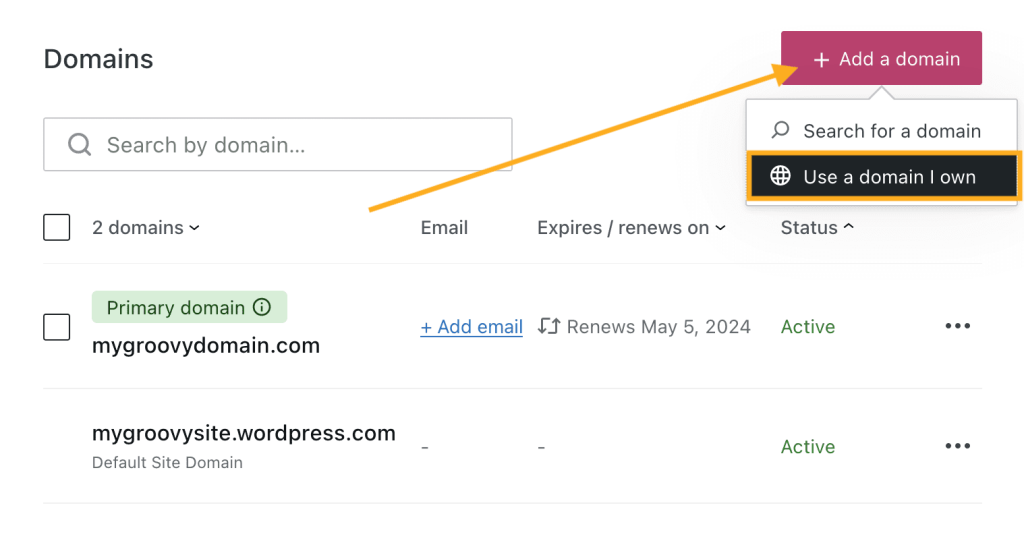If you own a domain name with GoDaddy, you can use that domain with your WordPress.com site. This guide will show you how to connect a GoDaddy domain to your WordPress site on WordPress.com.
In this guide
Connecting a GoDaddy domain to your WordPress.com site means:
- Your domain will show the site you created on WordPress.com, without the WordPress name in the address.
- You will continue to renew the domain name with GoDaddy unless you decide to also transfer the domain to WordPress.com.
Connecting a domain from GoDaddy is free with any paid WordPress.com plan.
- Starting from your WordPress.com dashboard, navigate to Upgrades → Domains (or Hosting → Domains if using WP-Admin).
- Click the “Add a domain” button and select “Use a domain I own” from the drop-down menu:

- Type the domain name you own and click the “Next” button.
- On the next screen, you will see two options: transfer or connect. Click the “Select” button next to “Connect your domain”. It may take a few moments to be redirected to the next screen.

- Click the “Start setup” button on the connect screen.
If you have connected multiple domains to your WordPress.com site, you may be prompted to verify that you own the domain before starting the setup process.
You have two options to connect your domain to your WordPress site: automatically setting up the domain connection (simple setup) or manually configuring your domain’s name servers (manual setup).
GoDaddy supports the Domain Connect standard, which saves you the hassle of making changes to your domain’s DNS manually. If your domain is eligible for the automatic setup option, follow the steps below:
- After adding the domain as described in the previous section, click on the “Start setup” button:

- You will be prompted to log into your GoDaddy account, where you can then click the “Connect” button to complete the process of connecting your GoDaddy domain to your WordPress.com site.
- If you click Cancel, the connection will be abandoned.

- You will be taken back to WordPress.com with a message that “We are verifying your connection now”.

The simple setup process may not be available in some cases. This is typically because your domain is not using GoDaddy’s default name servers or the domain has a custom DNS setup. In that case, follow the steps below to use the manual setup option to complete the domain connection process.
The manual setup process will walk you through updating your domain’s name servers to point to WordPress.com. Updating your name servers means your DNS records will be managed in your WordPress.com account instead of GoDaddy. If you have an existing email service from GoDaddy or another company, you may need to set up additional DNS records on WordPress.com to ensure that email service continues to function.
💡
You can also choose to switch to the Manual Setup option at the bottom of the Simple Setup screen. You will not see this option if you are already on the Manual Setup screen.
To update your name servers on GoDaddy, follow these steps:
- Log into your GoDaddy Domain Portfolio.
- Tick the checkbox(es) next to the domain(s) you wish to connect.
- Select Nameservers from the action menu.
- Depending on your screen size, you may need to select the More menu and scroll down to see Nameservers:

- Choose the “I’ll use my own nameservers” option.
- Enter the following values to connect your domain to your WordPress.com site, and manage your DNS with us on WordPress.com:
ns1.wordpress.com
ns2.wordpress.com
ns3.wordpress.com
- Select Save, then Continue to complete your updates.
Remember to remove your old name servers when adding the WordPress.com name servers. Your name servers should be set to only the three values listed above.
In case you have trouble making these changes yourself, you can contact GoDaddy support here to make the DNS changes for you. Here is a sample message you can send to them:
I would like to use my GoDaddy domain with a WordPress.com site. In order to do this, I need to point my domain’s name servers to the following:
ns1.wordpress.com
ns2.wordpress.com
ns3.wordpress.com
After changing the name servers, give it time for the change to take effect. After changing the name servers, the domain might not load right away. It is usually up and running within a few hours, but it can take up to 72 hours for the DNS to fully update across global servers and internet service providers.
To confirm the domain is connected to your site, try visiting the domain in a new tab in your browser. If it loads your WordPress.com website, then it’s working! You can also visit your Domains and look under the Status column to the right of your domain. It should say Active, like this:

If it still says Verifying, try waiting a few hours before taking the next step. Once you see the status change to Active, then your domain is connected. If the domain is still not loading the correct site, you may need to clear your browser’s cache to see the changes.
The final step is to go to Upgrades → Domains (or Hosting → Domains if using WP-Admin) and select your newly connected domain as the primary domain. See Set a Primary Address for more.
💡
Transfer Your Domain to WordPress.com
Want to manage your domain and website all in one place, instead of with two separate companies? Transfer your domain’s registration to your WordPress.com account, which you can do before or after connecting the domain. You would no longer pay any domain registration fees to your current domain provider, and would instead renew both your domain and website plan here at WordPress.com.